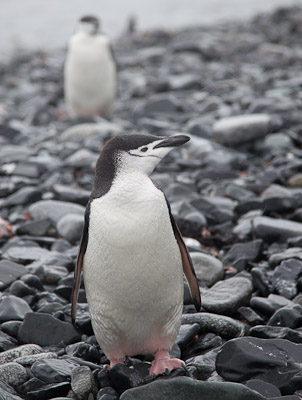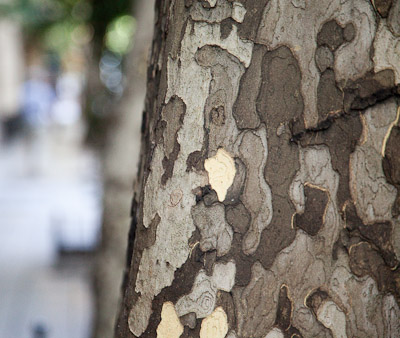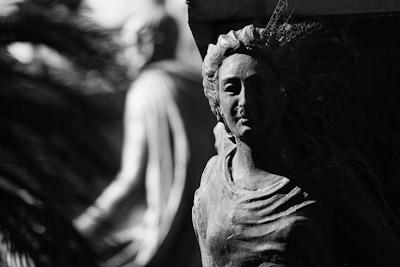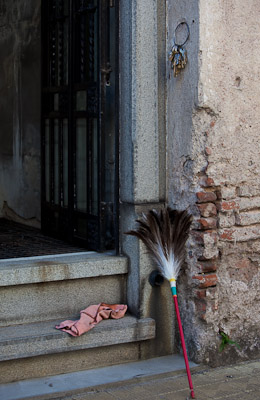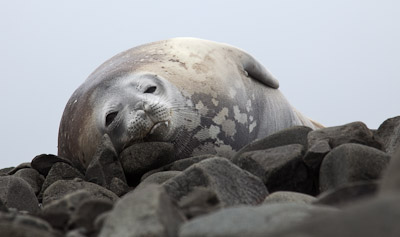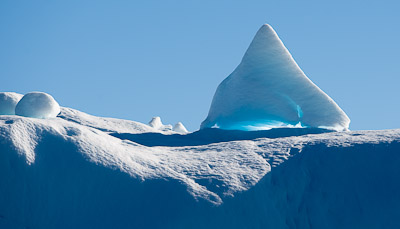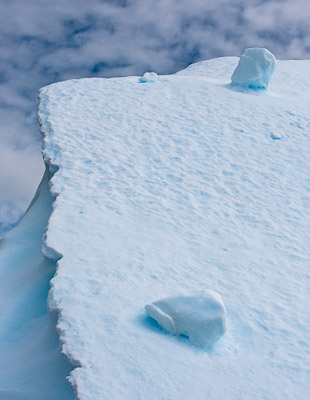By Chris Sanderson
Let’s be clear at the outset – the video files from the Canon 5D Mkii are very good and very useable, as has been shown by many examples posted on the web. I don’t think anyone needs confirmation at this stage that the Canon 5D MkII produces very good stills and good HD video. Rather, for me the question was whether this camera could be used successfully to cover both stills and video in the field. The answer is ‘maybe...’. Know the limitations of the camera and possibly discover your own – as I did.
Certainly the camera is highly competent for stills. For video it’s a bit of a stretch. A stretch both for the camera and the operator. This then is not really a review but more of a story of one person’s experience with the camera on location using it as the primary capture device to record both stills and video on a trip to Antarctica in January 2009.
Sad to say, this story was truncated prematurely: the 5Dii ‘died’ in the field after moisture exposure. I was not the only one to have similar moisture–related problems on our Antarctica trip. Out of 26 5Dii’s on Michael’s Antarctic expedition, fully 25% failed. The camera is certainly not waterproof. Canon says just that in the manual. But it would be good if it were moisture–proof or even resistant. It does not appear to be.
Chinstrap in the rain. Half Moon Island, S. Shetlands, January, 2009
Canon 5Dii with Canon EF 24–105
1/200 sec @ f/4 105mm
Precautions were taken against rain & moisture that were reasonable – but to no avail. In fact, two of the 5Dii’s that died were used inside waterproof Kata bags – and they died within a minute of each other out on location. My guess is that condensation was the culprit in almost all cases – mine died in the cabin an hour or so after exposure on the third day of the trip. I believed that the temperature shift between outside & inside that day was slight enough not to worry about condensation and interestingly, the temperature extremes were quite modest: from a mild +5 C to normal inside +20 C. Perhaps it was simply body heat and moisture build up from damp hands. Should my 5Dii have been the sole failure, I would have put the cause down to ‘User Error‘ but the fact that the failures occurred in such a high proportion from a reasonably large sample suggests a fundamental weakness in the camera build or a production problem.
Some of the failed cameras returned to life following the normal treatment in such cases: remove lens, CF card, battery & vertical grip; leave open to dry air and pray. If that does not work, then the judicious application of heat from a hair dryer inside a pillow case. For many this treatment worked but for my 5Dii and at least one other, it did not. Fortunately, I had been able to use the camera (loaned from Canon Canada) for a few days – not really long enough but just sufficient to make some reasonable observations.
______________________________________________________________
The Attraction
I have been shooting film and video motion pictures for many years starting with a16mm Bolex & Arriflex S back in 1970 using Ektachrome Commercial reversal film. Now 38 years later I am using a Sony EX1 and the tiny Sony SR12 to record HD video for the Luminous Landscape. I am a videographer first and a stills photographer second. My current style of shooting video is to take lots of shots to create plenty of coverage and then to spend considerable time editing that footage into a reasonable story or sequence. Only rarely do I use a tripod and video head since I find that I cannot move fast enough with heavy or bulky equipment. Neither can I get into cramped or hard–to–access spaces to get the angle or content that I am looking for. Many call this style of shooting ‘Run & Gun’. When you shoot like that, quite a lot of footage is left on the editing room floor, either because of ‘sub–optimal’ quality or because the shot adds nothing to the story. I am a documentarian and it is often only in the editing room that a story or sequence becomes apparent. I believed the Canon 5D Mkii presented an exciting opportunity to shoot in this style with the wonderful choice of lenses available. Most exciting of all to me was that the fullsize 35 mm sensor of the Canon5D Mkii meant that bugaboo of video production – seemingly endless depth–of–field – looked to be banished. Could I really use this camera as a replacement for a true video camera? Here are the results of those too–few days.
Street Tree Bark. Buenos Aires, January, 2009
Canon 5Dii with Canon EF 24–105
1/100 sec @ f/4 105mm
______________________________________________________________
Stills or Video?
The challenge was to see if something viewable could be made using a ComboCam – a video with stills or a still collection with a bit of illustrative video or maybe an as–yet–to–be labelled multimedia piece.
On location, my first reaction was to treat the camera as a still camera and take lots of still pictures. After all it looks and handles like a real stills camera. The video capability seems an afterthought, especially when you discover the lack of information in the manual and and the lack of hard video controls on the camera.
So, loving the ability to take stills, I took lots before I reminded myself to shoot some video. Now the challenge was to shoot video properly with lots of editable coverage in order to build a sequence and not just a simple moving version of a still. It certainly makes the mind stretch a little, used as it is to a groove with one capture device or the other. I have gone around a location with both types of camera before but never really succeeded in doing both well – the two disciplines really are quite different in approach with shots useful for a video storyline that would never be used as stills. And often having captured the video, the stills opportunity may have passed or been passed over!
Intriguingly though, this camera offers the ability to interrupt the stream of video capture with a stills capture. About two seconds of video is lost but you get a full 21 Megapixel still in its place as a separate file and the video holds the outgoing frame of the ‘edit’ as a freeze frame during the stills capture. One little thing to remember here though: the aspect ratio of the video is 16:9 and the aspect ratio of the still is 3:2. So if your intention is to use both the video stream and the still as part of a video sequence, it will need to be resized and letter–boxed to maintain the original aspect ratio. But at least the pixels are all square – unlike a lot of video.
Recoleta Statuary. Buenos Aires, January, 2009
Canon 5Dii with Canon EF 70–200
1/400 sec @ f/4 200mm
______________________________________________________________
Finding the Shot
The Canon 5D Mkii’s viewfinder presents a physical stretch: lovely for stills but absent with the mirror up for video. Pull the eye back to look at the Live View rear LCD screen for the video and it seems that my multi–focal eyeglasses will require a more chin–up look at the camera for vaguely–in–focus use – a stretch for those ‘of a certain age‘. Also, simply moving the camera away from the eye to view the rear screen changes the focus distance. This can be critical in shallow depth–of–field situations. So the focus technique for me was to use MF and the camera’s Live View ability to zoom in to 10x the frame, then check & adjust the focus manually, and only then shoot. I tried another method using AF before shooting video but that requires the mirror down, set focus, switch to Live View, shoot – and now with the camera away from the eye, the focussing distance has changed…
I am more than happy to live without auto focus – a double–edged sword for the videographer. MF is just fine by me. But for someone used to accurate AF when shooting stills, this too may be a new stretch.
The big excitement for someone coming from current video is the ability to use the 5Dii’s full-size chip in combination with good stills lenses. This gives the ability to isolate the subject with shallow depth of field. For the past ten years with tiny to small chip video, great depth of field has been virtually forced on the videographer. Now I can use selective focus just as I did when shooting 35mm motion picture film – actually with even greater selectivity since the sensor is about twice the size of a motion picture frame. Also, ND filters can be used to force a wider aperture. But this makes great demands on the accuracy of focus when shooting – especially wide open. My experienceshooting at night wide open with the 50mm 1.4 lensshowed me just how critcal focus is: depth of field in a close–up is just an centimeter or less. Interestingly however, the eye may not be as critical about picture softness when the subject or camera is caught up in the motion of video. In video the viewer can accept motion blur and occasional focus softness as the subject moves in and out of the sharp zone. So occasionally, this ‘error’ may be acceptable – but always with recourse to that sharp editor’s razor tool! Using this camera, I wish I had my old American Cinematographer’s Depth of Field charts. I will need to refresh my ability to judge the appropriateness of Focal Length / Aperture / Distance to Subject!
Exposure is also a challenge on the 5Dii. Exposure will shift with the light as the camera moves across a scene. Therefore the technique must be to evaluate the shot beforehand and use the AE Lock button – unless the change is too extreme, in which case an exposure change, or ‘stop–pull’ in movie parlance, can save the shot. Depth of field preview is also important here so that the appropriateness of aperture and depth of field can be judged.
______________________________________________________________
Lens Choice
It seems to me that the results of hand–holding any lens for video longer than about 90mm are at best, questionable. In fact any lens over 50mm that does not have Image Stabilisation will likely be difficult for handheld use. This is not a particularly easy camera to handhold since when using Live View the camera is necessarily held away from the body, magnifying any camera movement. Image Stabilisation works very well for focal lengths between 50 & 100mm – beyond that, a tripod and head are essential. The short focal length zooms are then ideal for shooting movies handheld and the 50mm 1.4 and extreme wides can be really useful when low light or extreme field of view are required. If I were to continue to shoot with this camera, I would have to engage my tripod and video head far more than usual. I often shoot the Sony SR12 at focal lengths equivalent up to 400mm – but this is simply not an option with the 5Dii. So, the 70 – 200mm and 300 & 400mm that I would so much like to use would require all that gear that I prefer to leave behind on location. A couple of handheld rigs I would like to experiment with are Manfrotto’sFigRigand theBushHawk.
Recoleta Dusters. Buenos Aires, January, 2009
Canon 5Dii with Canon EF 70–200
1/160 sec @ f/4 70mm
Here is a short video clip shot in Buenos Airesas Michael & I walked from our hotel to the Recoleta cemetery. I have resized it to 50% and it is quite compressed for web viewing.
______________________________________________________________
Handling
On reveiwing a morning’s shooting on Desolation Island, I discovered lots of unwanted footage. If you forget to switch off Live View, the Set (shoot) button is very easily activated by camera handling in and out of a bag, or simply by walking with the camera bouncing against the chest. Apart from teaching me to switch off Live View (a good idea!), this also showed me that, with an 8 GB CF card, I was easily able to shoot a scene of over 16 minutes – albeit of my swinging feet and gyrating ground!
A small annoyance that I eventually learned to overcome was the accidental use of the Menu button when what I wanted was the adjacent Live View button; my fingers eventually learned, but the buttons are very close to each other for someone with large fingers and/or gloves. Other than that, I was quite happy with the way the camera handled.
I had expected battery life to be seriously compromised by the cool temperatures and the extended Live View movie shooting. This was not the case. Battery life with the 2 battery vertical grip was very good and a full 4 hours of shooting never moved the battery readout down more than 50%.

Elephant Seal Slough. HO Island, S. Shetlands, January, 2009
Canon 5Dii with Canon EF 24–105
1/200 sec @ f/4.5 105mm
______________________________________________________________
Documentation & Settings
Canon’s 5Dii camera Manual gives only four sketchy pages on Movie shooting and they are mostly filled with warnings. There is very little to actually help the operator, and most information for movie shooting comes from a careful parsing of the stills shooting directions. Full manual control is not really available.The key missing piece of information is that the movie mode picks up the settings for JPEG stills shooting. It is critical therefore – especially if you are used to shooting stills in RAW mode and ignoring JPEG – that you check and set the JPEG settings for White Balance and Picture Style. I never got to play much with the adjustments available in Picture Style, but I normally always zero out the sharpening and reduce the saturation & contrast somewhat. These settings can be saved into any of the four available Picture Styles. This is a matter of taste naturally, but for me it gives a more pleasing look and contrast can always be added later. Experimentation is necessary.
The ISO and the ‘movie’ sRGB colour space are set automatically for video shooting. I also believe that noise reduction in high ISO shooting and automatic image brightness correction is applied, but I cannot find confirmation of this.
The most important manual control available to movie shooting is the +/– 2–stop exposure compensation. Metering is based on centre-weighted averaging (unless face detection mode is used). Being able to set and lock exposure is critical and that at least is available. Shutter speed is not adjustable and I believe it to be the standard NTSC 1/60 sec or 1/50 if you have the PAL version.(SeeUPDATESbelow)
Weddell on the Rocks. HO Island, S. Shetlands, January, 2009
Canon 5Dii with Canon EF 24–105
1/200 sec @ f/8 105mm
______________________________________________________________
The Video files
Playing back the HD video on location is problematic. HD monitors are not easy to lug around and the files themselves with the Canon variant of H264 encoded .mov files can pose some challenges. On the first couple of days, I was disturbed to see considerable jerkiness in high motion sequences. This however turned out to be simply a playback problem. At 100% (1920 x 1080) the files put considerable stress on both the cpu and the video card – H264 is quite processor intensive. When the machine cannot keep up to the ‘in–betweening’, it simply skips the motion and goes to the next keyframe. This results in playback jerkiness. But if the video is reduced to 50% size or smaller, the video plays back smoothly. Strangely I also found that Apple’s Final Cut Pro had much more difficulty playing the files than did QuickTime Player – something I guess that is due to the additional overhead of a full–up editor. My solution to this is to re–encode all the video files to the Apple ProRes 422 format. This allowed the video to play smoothly at full resolution and editing became much easier. Note that The Apple Pro Res files are about 5 times bigger than the originals!
My friend Neil Enns also shot with the 5Dii on the Antarctic trip (his didnotdie!). He was quite unhappy with the playback problems on Windows and found the only software that could play back the files natively wasVLC Media Player. This is a brilliant ‘Swiss Army Knife‘ media player for Windows, Mac OS X, Linux and other platforms; it generally solves any playback problems with most video or audio files. Neil plans on transcoding all his footage to MP4 before editing.
There is a Standard Definition video format available in the 5Dii (720 x 480). This gives much smaller files but still very acceptable resolution for a lot of video work. I know it’s seems a shame to waste all those available pixels, but this format would be much more suitable to those editing on location or to those who are using the video of the 5Dii as a video note–taking device.
Ice Shape 1. Antarctica, January, 2009
Canon 1Diii with Canon EF 70–200
1/1250 sec @ f/4.5 200mm
______________________________________________________________
What to do with the Video?
On the Antarctic trip, I was asked to give a presentation on video for beginners. In that I asked those in the audience to ask this question of themselves: ‘What am I going to do with the video I shoot?" It is important to know if you want the video to be more than visual note–taking.
Most people will want to show the video to others – at least to their friends and family and then possibly to a wider audience on the web. My caution is that if you are asking others to watch and listen to your efforts, make it worth their while. Having some rough video clips such as those I have shown here is essentially unsatisfying. A more complete production with soild story–telling and a good soundtrack will be far more watchable and rewarding for all. Enter the video area with the same attention to craft as you would with stills. This means learning not only how to shoot but more importantly how to edit to build interest and to create a story. New skills must be learned: likely the most important of which is to learn how to build and mix a good soundtrack. Sound is at least half of the show.
Here is a second short video clipassembled from footage shot with the Canon 5Dii – again it is reduced in size to 50% and compressed for web delivery.
Ice Shape 2. Antarctica, January, 2009
Canon 1Diii with Canon EF 70–200
1/1000 sec @ f/5.6 70mm
______________________________________________________________
Conclusion
So what do I draw from this short story? I believe the Canon 5D MKII is a great first (sorry Nikon – second) step toward a new breed of camera that can capture both still & video work well.
But since the video portion of the 5Dii’s functionality appears to be an afterthought, video handling and implementation are rudimentary. However the files promise well for the future since the underlying technology is very strong. The failure of this particular camera is in its build and operation for video and general lack of reliability in normal field conditions.
I want to thank Canon for letting me try this experiment and whilst a failure, it was not completely so. I was allowed a glimpse of a very promising future. Is a truly functional ‘ComboCam‘ too much to ask? I do not believe so. There is now so much similarity in the basic technology of both stills & video that It is hard to imagine that a manufacturer wouldnotdevelop this type of image capture device. And there are many photographers who want to produce both good stills and good video. This certainly whettedmyappetite.
I am not going to buy a 5Dii. But whenever a successor comes along that can deliver both stills & video on an equal footing, I will be first in line. All that good glass in my kit – so long ignored for video – is waiting!
The main lesson learned for me is that I will need to repolish & refine the skills learned years ago with 35mm & 16mm motion picture making. The process will tolerate little technical error and a whole new set of handling skills are needed to execute decent video.
______________________________________________________________
UPDATE:Feb 16, ’09
Since this article was published, I have been contacted by a reader who gives the following procedure for manually setting both the exposure and shutter speed for a video scene:
Aperture & shutter control on the 5D2 is possible, but it’s not straight forward.
– Camera in Aperture mode.
– Live View set to Exposure Simulation.
– ISO should NOT be set to Auto or it will shift whenever the 5D2 ‘thinks’ it’s needed.
– Exposure Lock must be engaged before filming. The Aperture is easy to lock down, picking up whatever was set by Aperture Priority, but the shutter is a pain. I point it at brighter or darker subjects to get it where I want, usually between 30th & 60th, then hit the Exposure Lock. If the wrong shutter speed gets set another press of the Exposure Lock can change it or a double press on the Review/Playback button will completely clear the lock.
– Finally I hit ‘Set’ to begin filming.
– Exposure Simulation shows the entire 3:2 chip, but when the Record button is hit the image goes 16:9, which is a huge pain. I end up running through this entire process several times trying to get the composition right.
______________________________________________________________
UPDATE:Feb 25, ’09
This method of achieving manual control has been challenged. It may well be that the user thinks that manual control is achieved when in fact it has not…
The issue of manual control, or rather the lack of it, is dealt with along with many other aspects of video on the 5Dii atcinema5d.com.
______________________________________________________________
UPDATE:June 2, ’09
Hooray! Full Manual Exposure Control!
Why it wasn’t there at the beginning – who knows?
But good news that with afirmware update, the 5Dii now has full manual ISO / Shutter Speed / Aperture adjustment that goes a long way to making this a great video capture device.
ISO can be set between 100 and 6400.
Shutter speed between 1/30 and 1/4000.
Aperture is available as on the lens being used.
______________________________________________________________
Chris Sanderson – February, 2009
Chris Sanderson is a prize–winning commercial director as well as an experienced cameraman and editor. With more than 38 years experience in the motion picture and video industry, he is the producer of The Luminous Landscape Video Journal and this site’s instructional videos.
You May Also Enjoy...
Beartooth Mountain Goats
Living The High Life© Miles HeckerCLICK ABOVE IMAGE TO SEE GOOGLE MAP LOCATION SEASONS There is a herd of several dozen mountain goats that hangs
Tough and Sweet
"Tough" and "Sweet" I'd like to try out an idea on you. You know, kinda throw it at the wall and see if it sticks.
